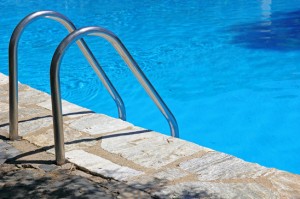Pacific Gas and Electric’s Code and Standards Enhancement (CASE) Initiative for efficient Pool Pump comparison has provided some much needed guidance for understanding and comparing pool pump efficiency and selection of in ground and above ground pool pumps. Pump efficiency varies with flow rate and head. Selecting an efficient pump for your pool means selecting a pump with a flow rate close to the design flow rate for the pool system. The design flow rate should be chosen to be no fewer than 8 hours per day for residential private pools. In addition to applying proper design practice, there are two approaches to improving efficiency. These include high efficiency pump-motor combinations and using pumps with two-speed motors. Using pumps with two-speed motors offer the most significant opportunity for energy savings by taking advantage of pump affinity laws, that state that the power consumed by a pump is proportional to the cube of the flow rate. In example, the power required to pump one half the flow rate is one eighth the power required to operate at the full flow rate. Operating a pump equipped with a two-speed motor at half speed for twice as long therefore moves the same volume of water, but in theory uses only one-quarter the amount of energy.
What’s Pump Efficiency
Unlike motor efficiency, pump efficiency varies substantially with load. Pump (impeller-volute) efficiency can be determined by testing, but is seldom reported and is not regulated by state or federal standards. The efficiency of pool pump and filter systems can also be improved by properly matching pumps to system flow and pressure head requirements. Service factor is a measure of how much a pump motor can be under-sized without overloading the motor. For example, a 1 HP pump with a service factor of 2.0 draws about the same power as a two-horsepower pump with a service factor of 1.0. The reasons for marketing high service factor pumps are unclear, but the practice creates confusion and could be contributing to inappropriate pump sizing.
Design Life and Life Cycle Cost of Efficient Pool Pumps
The average service life of swimming pool pumps is ten years in accordance with data collected by the Department of Energy in Priority Setting for New Products, published on October 26, 2001. Newer technologies and light weight components have not altered this data by much. Testing or labeling would not affect design life. No data are available to determine whether low speed operation extends or shortens motor life. Since motor life is principally determined by speed and heat, one might speculate that a two-speed motor operating at low speed would last longer, since the speed and heat would be reduced. A comparison of the high efficiency and two-speed pool pumps for life cycle cost by the California Energy Commission 2000 Appliance Standards indicated that the 2 speed pumps had a lower life cycle cost than the high efficiency pumps.
